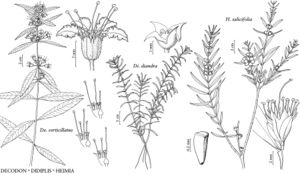Decodon verticillatus
Sketch Bot. S. Carolina 1: 544. 1821. (as verticillatum)
Leaves: petiole 3–12 mm; blade 30–200 × 5–50 mm, surfaces glabrous or puberulent abaxially, trichomes pale brown. Inflorescences 6–24-flowered. Pedicels 4–13 mm. Floral tube 5–8 × 3–5 mm, glabrous or puberulent; epicalyx segments linear, 2–3 mm; petals obovate or elliptic, 8–15 × 3.5–6 mm; stamens in 2 whorls, of 3 lengths, each flower with 2 of the 3 lengths. Capsules globose, loculicidally dehiscent. Seeds 1.5 × 1.5 mm; embryo surrounded by dense, small-celled spongy tissue. 2n = 32.
Phenology: Flowering summer–fall.
Habitat: Swamps, marshes, margins of lakes, ponds, or pools, margins of pools in fens.
Elevation: 0–500 m.
Distribution
N.B., N.S., Ont., P.E.I., Que., Ala., Ark., Conn., Del., D.C., Fla., Ga., Ill., Ind., Ky., La., Maine, Md., Mass., Mich., Minn., Miss., Mo., N.H., N.J., N.Y., N.C., Ohio, Pa., R.I., S.C., Tenn., Tex., Vt., Va., W.Va., Wis.
Discussion
The distinction made between glabrous inland and puberulent coastal plain populations of Decodon verticillatus has proven only partly accurate. Plants with some degree of indument are the most common form throughout the range; there are relatively few individuals that are entirely glabrous. There are no distinct geographical limits based on presence or absence of trichomes. Regional variability is seen in the extent to which the three style morphs are expressed; mid-style floral morphs are absent toward the northern limits of the range (M. E. Dorken and C. G. Eckert 2001).
Selected References
None.
